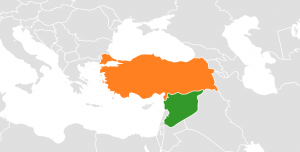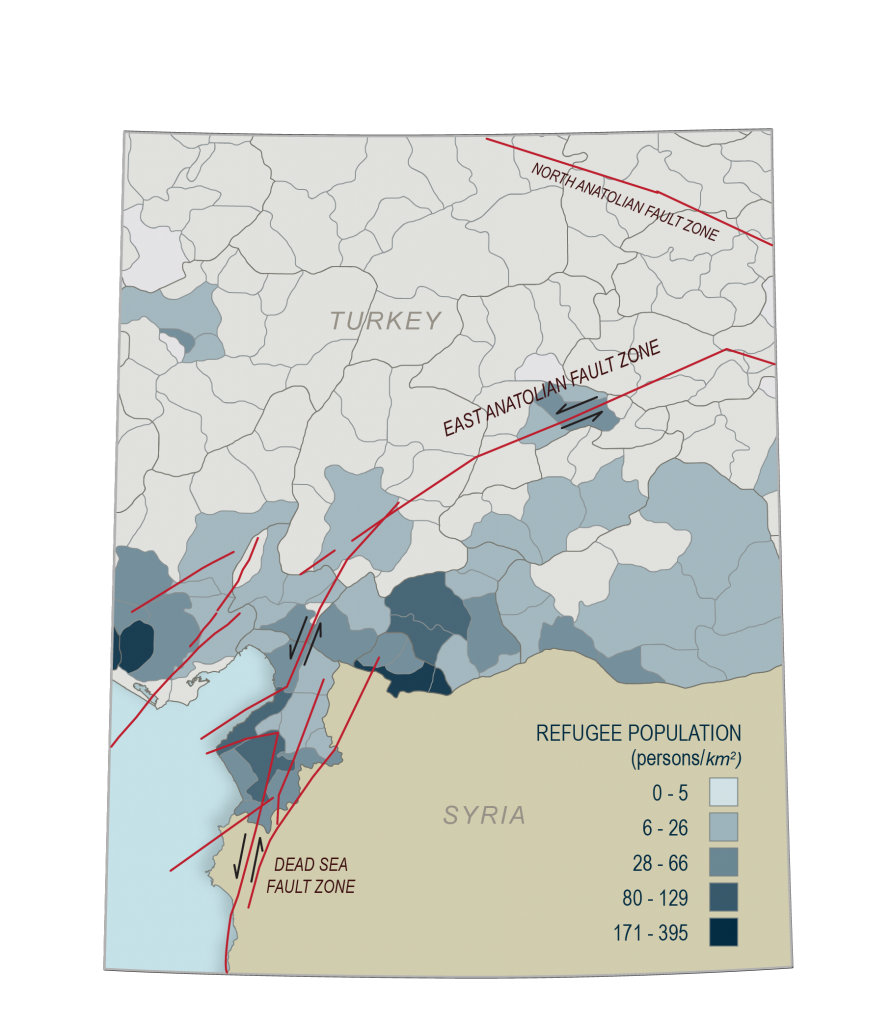13 December 2016
Included in this announcement:
- Research from the AGU Fall Meeting: Syrian refugees face new obstacle: Turkish earthquakes
– Media Q&A with researcher and presentation information - Today’s press events
- Noteworthy sessions happening today
- Press networking events happening today
- Potentially newsworthy sessions
- Online media resources
Please visit the 2016 Fall Meeting Media Center to view previous media advisories that include important information about press registration, badge pickup, quiet rooms, searching the scientific program, and AGU On-Demand.
Earthquake deaths in Turkey could rise by 20 percent when Syrian refugees are factored into risk assessments
** Note: The AGU Fall Meeting press office will hold a media Q&A with the researcher at 8:30 a.m. PT today. Click here for more details. **

A map showing the border between Syria and Turkey. More than 2.5 million Syrian refugees who fled to Turkey in the past five years now live in seismically active regions.
Credit: AteshCommons: Own work, CC BY-SA 3.0.
SAN FRANCISCO — Syrian refugees seeking reprieve from civil war may have traded a violent home for a different danger: deadly earthquakes, according to new research presented here today.
More than 2.5 million Syrian refugees who fled to Turkey in the past five years now live in seismically active regions, many with histories of powerful tremors. Yet their presence is not reflected in the data traditionally used to produce risk assessments, which scientists and agencies use to mitigate and respond to natural hazards, according to Bradley Wilson, a geoscientist at the University of Arkansas in Fayetteville, Arkansas.
Including Syrian refugees in Turkey’s earthquake risk assessments could boost the death toll from a major earthquake in the country’s most populated districts along the Syria-Turkey border by up to 20 percent, potentially causing hundreds or thousands more casualties than currently projected, according to Wilson’s new research.
The research highlights the importance of including physical, political, cultural and socio-economic factors in natural hazard risk assessments, Wilson said.
“It is vital to remember that Syrian refugees migrating northwest into Turkey are migrating to areas constructed on the ruins of cities that have been repeatedly destroyed in large earthquakes,” said Wilson, who will present the results of his research today at the 2016 American Geophysical Union Fall Meeting.

This map depicts both Turkey’s fault lines (in red) and the distribution of refugees living within the country’s districts (in shades of blue).
Credit: Bradley Wilson.
Turkey lies atop several active fault zones, which have produced some of the world’s deadliest earthquakes. The 7.8-magnitude Erzincan earthquake struck northeastern Turkey in 1939, claiming nearly 33,000 lives and demolishing the city of Erzincan. More than 600 years earlier, an earthquake estimated to be of magnitude 7.0 struck the area known today as the Adana province, killing roughly 60,000.
Wilson’s study area spanned regions surrounding the Turkey-Syria border, where both seismic activity and refugee numbers are high. Using a combination of population and refugee data, Wilson compared the regions’ populations before and after the Arab Spring in 2011 to depict how refugee migration affected the country’s earthquake-prone districts. Using Turkey’s seismic records, he then simulated multiple earthquake scenarios and forecasted casualty tolls under magnitude 5.8, 6.4 and 7.0 earthquakes.
Incorporating refugees into Turkey’s earthquake risk assessments significantly shifted the study area’s high-risk zones. Before refugee migration, most at-risk areas were near the country’s center. While those areas remain high-risk, including refugees shifts the most at-risk regions to the south, where most refugees now live.
Under worst case scenarios, where a magnitude 7.0 earthquake strikes Turkey’s most populated districts, the study suggests the death toll could rise by 20 percent over current estimates. Deaths could rise by at least 3 percent if a magnitude 5.8 earthquake were to strike in a less populated district, according to the new research.
“If ignored, these discrepancies ultimately complicate the work of the scientists and agencies who work to mitigate and respond to earthquake disasters,” Wilson said.
###
Media Q&A and presentation information
The researcher, Bradley Wilson, will be available to answer questions from members of the news media during a media Q&A from 8:30 – 9:00 a.m. PT today in the Press Conference Room, Moscone West, Room 3000. The media availability will also be streamed live over the web. Information about how to stream press conferences can be found here.
The researchers will present a poster about their work on Tuesday, 13 December 2016 at the AGU Fall Meeting.
Session:
NH23A: Model, Tools, Techniques, and New Data Streams for Natural Hazards and Emergencies II Posters
Date: Tuesday, 13 December 2016
Time: 1:40 – 6:00 p.m.
Abstract number: NH23A-1851
Location: Moscone South, Poster Hall
Contact information for the researcher:
Bradley Wilson: [email protected], +1 (708) 519-0442
8:30 a.m. – New obstacles for Syrian refugees (Media Q&A)
9:00 a.m. – First results from the Norwegian Young Sea ICE Expedition
10:30 a.m. – Arctic Report Card 2016
11:30 a.m. – News from Gale Crater: Recent findings from NASA’s Curiosity Mars Rover
1:30 p.m. – Tracking the reorientation of the terrestrial planets
2:30 p.m. – Direct from New Zealand: The Kaikoura earthquake
4:00 p.m. – The path forward from Paris, one year later (Media Availability)
5:00 p.m. – Integrating scientific research into local decision making
All Fall Meeting press events will be streamed live on the AGU press events webpage and archived on AGU’s YouTube channel.
- The Frontiers of Geophysics Lecture, “Shifting the Energy Mix in a Post-Paris World,” will take place from 12:30 – 1:30 p.m. in Moscone North, Hall E. The panel will present economic, scientific and industry viewpoints on future energy demand, the shifting energy mix/energy tradeoffs and the economic, social, and political drivers of those shifts in a post Paris COP21 world. The lecture will be streamed live on AGU On-Demand and in the Press Conference Room, Moscone West, Room 3000.
- The Path Forward from Paris, One Year Later: A panel of high level science policy experts from around the world will discuss the outcomes of COP21/CMP11 and implications for both the research, policy, and action agendas at local, regional and global scales. Margaret Leinen, AGU President, will host the panel, which will take place from 1:40 – 3:40 p.m. in Moscone North, Hall E. This session will be streamed live on AGU On-Demand. A media availability will be held immediately following this session in the press conference room, Moscone West, Room 3000.
Registered journalists who are interested in attending these events should meet an AGU staff member at the entrance to the lecture hall 30 minutes prior to the start of the talk. Press should meet in front of the doors to the right of the escalators: When you are at the bottom, facing the escalators, the doors are to the right of the escalators. When you are coming down the escalator, turn left at the bottom of the escalators.
Members of the media will be able to meet and mingle with colleagues at several events throughout the week. Here is what’s happening today:
NCSWA Holiday Dinner: California’s redwoods in a changing climate – Dec. 13
[The following is provided on behalf of the Northern California Science Writers Association.]
AGU press are encouraged to join their colleagues in the Northern California Science Writers Association for NCSWA’s annual holiday dinner on Tuesday, December 13. This year’s speaker is noted UC Berkeley ecologist Todd Dawson, one of the world’s leading authorities on redwood trees. Dawson will discuss the impacts of climate change on California’s redwoods and his high-altitude forest research, featured prominently in National Geographic and other outlets.
Details:
Tuesday, December 13, 6:00 p.m. – 9:30 p.m.
L’Olivier, 465 Davis Ct. (within walking distance of Moscone Center)
Cost for non-NCSWA members: $45
NCSWA encourages AGU press to register online in advance as the event may sell out.
- Assessment of the extent of land deformation associated with salt domes within the Jazan City and surroundings, Saudi Arabia
9:00 – 9:15 a.m., Moscone West, Room 3002, Session G21C - Scaling of dielectric breakdown thresholds in Earth’s and CO2-rich atmospheres: Impact for predictions of extraterrestrial transient luminous events and lightning discharges
9:45 – 10:00 a.m., Moscone West, Room 3001, Session AE21A - The High Arctic’s only great lake is succumbing to climate warming
1:55 – 2:10 p.m., Moscone West, Room 3003, Session GC23J - An outrageous geological hypothesis for the early Mars hydro-climatic conundrum
2:55 – 3:10 p.m., Moscone West, Room 3002, Session P23E - AGU journal editors recommend these sessions happening today.
For journalists: During the Fall Meeting, journalists can find many resources online in the Virtual Press Room in the Media Center on the Fall Meeting website. These resources include press releases, press conference materials and other information. Videos of press conferences will be added to the Virtual Press Room during the meeting for easy online access.
For public information officers: PIOs are now able to share press releases and other materials in the Virtual Press Room by directly uploading them via the Press Item Uploader. PIOs can upload press releases, tip sheets and press conference materials to the Virtual Press Room at any time before or during the meeting, including uploading items in advance and scheduling them to post during the meeting.
The AGU press office is offering two new online tools to connect reporters with scientific experts at the 2016 Fall Meeting. The Find an Expert tool allows public information officers to list scientific experts who are available to be interviewed by reporters at the meeting. The Request an Expert tool allows reporters to send requests for experts directly to PIOs.
More information about these tools can be found in the Fall Meeting Media Center.
###
The American Geophysical Union is dedicated to advancing the Earth and space sciences for the benefit of humanity through its scholarly publications, conferences, and outreach programs. AGU is a not-for-profit, professional, scientific organization representing more than 60,000 members in 139 countries. Join the conversation on Facebook, Twitter, YouTube, and our other social media channels.
Nanci Bompey
+1 (914) 552-5759
[email protected]
Lauren Lipuma
+1 (504) 427-6069
[email protected]
AGU Fall Meeting Press Room:
Moscone West, Room 3001A
+1 (415) 348-4404
[email protected]